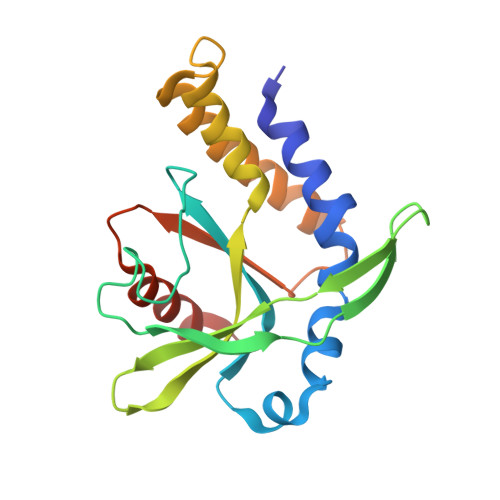Ancient Origin of cGAS-STING Reveals Mechanism of Universal 2',3' cGAMP Signaling.
Kranzusch, P.J., Wilson, S.C., Lee, A.S., Berger, J.M., Doudna, J.A., Vance, R.E.(2015) Mol Cell 59: 891-903
- PubMed: 26300263
- DOI: https://doi.org/10.1016/j.molcel.2015.07.022
- Primary Citation of Related Structures:
5CFL, 5CFM, 5CFN, 5CFO, 5CFP, 5CFQ, 5CFR - PubMed Abstract:
In humans, the cGAS-STING immunity pathway signals in response to cytosolic DNA via 2',3' cGAMP, a cyclic dinucleotide (CDN) second messenger containing mixed 2'-5' and 3'-5' phosphodiester bonds. Prokaryotes also produce CDNs, but these are exclusively 3' linked, and thus the evolutionary origins of human 2',3' cGAMP signaling are unknown. Here we illuminate the ancient origins of human cGAMP signaling by discovery of a functional cGAS-STING pathway in Nematostella vectensis, an anemone species >500 million years diverged from humans. Anemone cGAS appears to produce a 3',3' CDN that anemone STING recognizes through nucleobase-specific contacts not observed in human STING. Nevertheless, anemone STING binds mixed-linkage 2',3' cGAMP indistinguishably from human STING, trapping a unique structural conformation not induced by 3',3' CDNs. These results reveal that human mixed-linkage cGAMP achieves universal signaling by exploiting a deeply conserved STING conformational intermediate, providing critical insight for therapeutic targeting of the STING pathway.
- Department of Molecular & Cell Biology, University of California, Berkeley, CA 94720, USA; Howard Hughes Medical Institute (HHMI), University of California, Berkeley, CA 94720, USA.
Organizational Affiliation:

















